Test – Gigabyte Brix S GB-BXi7H-5500: Specs | Price | CPU | Profitability| Hashrate| best Coins | Config | Advantage (Pros) and Disadvantages (Cons) and other important features that will help you make better decision.
Mini-PCs are flourishing and all manufacturers offer more or less small models, Gigabyte has its Brix series (which I tested in its Pro i7 4770r version here), a range that offers several models equipped with processors ranging from the Intel Celeron 3205U to the powerful 5th Generation i7 (Broadwell) 5500U. Let’s see what the Brix of today’s test (which is none other than an update of the first Brix) has in the belly!
Specification: Hashrate – Gigabyte Brix BXi7H-5500
| Gigabyte Brix BXi7H-5500 | |
|---|---|
| Dimensions | 4,68 x 10,7 x 11,4 cm |
| Processor | Intel® Core™ i7-5500U |
| Processor frequencies | Turbo: 3,00 GHz Non Turbo: 2.40 GHz |
| Graphics chipset | Intel® HD Graphics 5500 |
| Graphics chipset frequencies | Maximum: 950 Mhz Base: 300 Mhz |
| Memory | 2 x SO-DIMM DDR3L 1.35V 1333 – 1866 MHz Maximum de 16 Go |
| Network | Gigabit LAN (Realtek RTL8111G) IEEE802.11ac, Dual Band & BT 4.0 |
| Audio | Realtek ALC283 |
| Maximum resolutions | HDMI: 4096 x 2304 @ 24 Hz Mini Displayport: 3840 x 2160 @ 60 Hz |
| Slots d’extension | 1 mSATA slot 1 mini-PCIe slot occupied by WiFi + BT card 1 SATA slot |
| Front connectors | 2 x USB 3.0 1 x prise jack |
| Connection at the back | 1 x HDMI 1 x Mini DisplayPort 2 x USB 3.0 1 x RJ45 1 x DC-In 1 x Kensington |
| Storage | 1 x Sata3 6Gb Compatible hard drives / SSD 2.5 “(7 or 9.5mm) |
| Food | Input: AC 100-240V Output: DC 19V 3.42A |
| Supported operating systems | Windows 7 32/64bit Windows 8.1 64bit |
| Guarantee | 2 years |
| Price | 550 € TTC |
The first thing that strikes you here is the size of the machine, a small cube of 11cm sides and 4.68cm high, we still lose almost 1.5cm in height compared to the original Brix, which was already very small.
The processor is therefore a Core i7 5500U running at a maximum turbo frequency of 3GHz (2.4GHz base), contrary to what one might think and at the original Brix this i7 only has 2 physical cores with hyperthreading against 4 cores physical with hyperthreading, performance should therefore be lower but more in line with the size and use of the end. The graphics part is left to an HD 5500 chipset clocked at 950 Mhz in turbo mode and 300MHz when the processors are used at 100%, the performance should also be less good than the Iri Pro which equipped the Brix Pro that I tested previously!
In terms of memory, it is possible to install SO-DIMM memory (the same as laptops) 1333, 1600 or even 1866 MHz (in OC mode) with a maximum voltage of 1.35V for a maximum of 16GB .
The storage part consists of an mSata port intended to accommodate an SSD and a Sata 3 6Gb / s connector for a 2.5 ″ hard drive or SSD.
Of course, the network part is very well supplied with 1 Gigabit RJ45 port and 1 811ac / Bluetooth WiFi card which should allow everyone to connect the Brix to their network.
The connection is not left out either with 2 USB 3.0 ports at the front as well as a 3.5mm jack output and at the rear 2 USB 3.0 ports, 1 HDMI port, 1 Mini DisplayPort, 1 RJ45 port as well. than a Kensington slot is not bad for such a small device!
Well that’s all well and good, but what about the price? Offered at around 550 € the Gigabyte Brix GB-BXi7H-5500 is not cheap, but cheaper by around 150 € compared to the Brix pro equipped with an i7 4770R, you also need to get an mSata disc (or 2.5 ″) And memory to have a functional machine.
Place the unpacking of the beast!
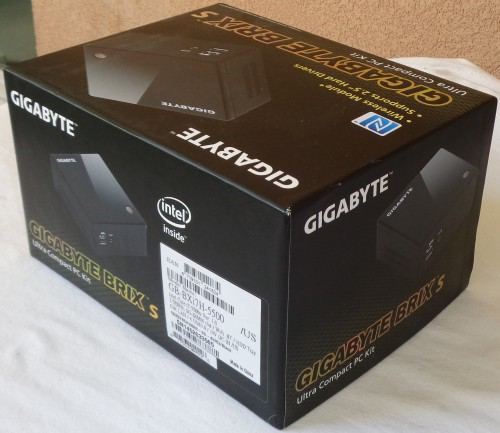
Here is the box! It will certainly not take much space in the cabinet you can be sure, on the top there is a profile photo of the product with only the mention of the model and a small listing of the beast’s strengths, a module without wire (Wifi and Bluetooth) as well as support for 2.5 ″ format discs.
At the back we find various photos highlighting the connections, the internal layout as well as the third-party components necessary for the operation of the Brix (2.5 ″ hard drive or mSata Drive, SO-DIMM memory and of course an operating system) .
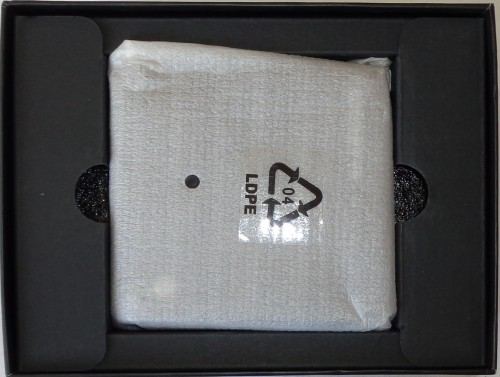
Once the box is open (very rigid, however, the transport should not damage the precious!) There is a first compartment accommodating the tiny Brix in a foam bag.
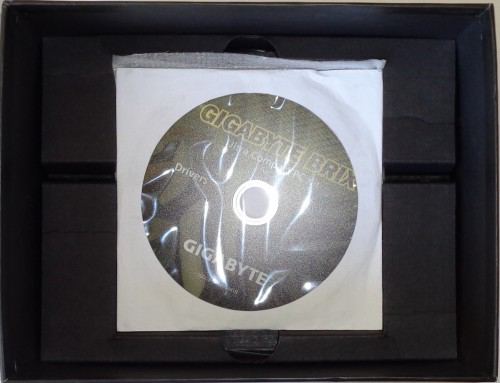
Once the first compartment has been removed we come across the second housing the driver CD, the VESA plate (for mounting behind a screen) as well as the various screws and the power supply.
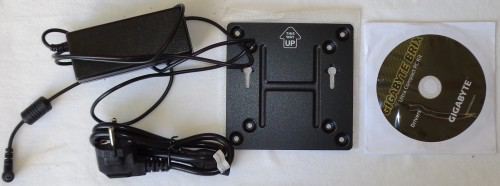
Here’s everything that’s in the Brix S box!
The bundle consists of:
- 1 Brix GB-BXi7H-5500
- 1 external power supply
- 1 mains cable
- 1 VESA plate
- 1 CD de drivers
The bundle is therefore rather basic with the essentials necessary for connecting and placing the Brix. The VESA plate will be particularly practical to hide the mini-PC behind a screen.
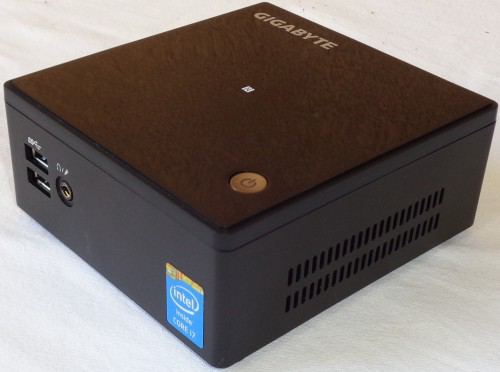
Here is the beast! All dark gray shiny metallic, the little one is very sober and very compact and robustness is essential. The power button is placed on the top and will therefore be easy to access. We can see very clearly that the beast is lower than its big brother Brix Pro, which was already really very compact, as you can see here.
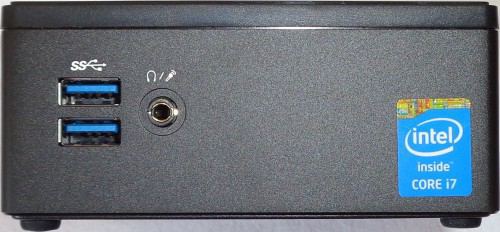
On the front we are entitled to 2 USB 3.0 ports as well as a 3.5mm jack that makes headphone and microphone, let’s not forget the little Intel Core i7 sticker that goes well.

There are small ventilation grilles on both sides, they will be needed to evacuate the heat of all these little people.

The rear connection is rather well provided for a device of this type with 1 HDMI port, 1 mini DisplayPort port, 1 Gigabit RJ45 port as well as 2 USB 3.0 ports. Of course ventilation grilles are present here!

Below we find again a small ventilation grid as well as the various labels of use, we learn that the Brix is made to work with a 19V and 3.42A power supply or 65Watts, much less than the Brix Pro and its 135 Watts , that should be more than enough for this small configuration.
Why not open the beast now!
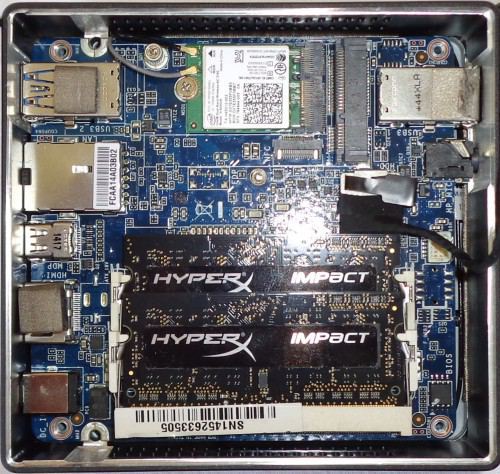
The motherboard! Everything is really miniaturized here, we see the 2 memory modules and the unused mSata port which is located just above the Wifi / Bluetooth module. The layout of the components is identical to the Brix Pro but the motherboard itself is not identical.
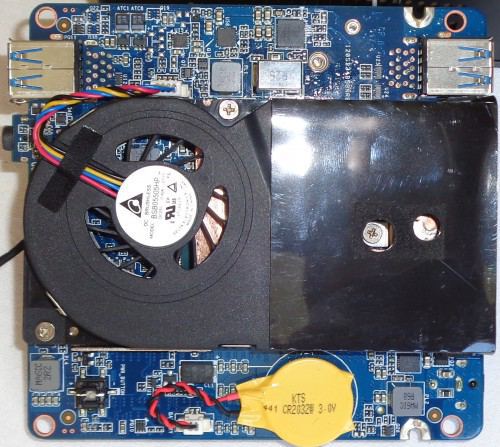
Below we can see the cooling system, which is all in all tiny and much smaller than that of the Brix Pro, given the size of the fan we will have to expect it to run very quickly and therefore to the noise pollution that go with it, but we’ll see that later
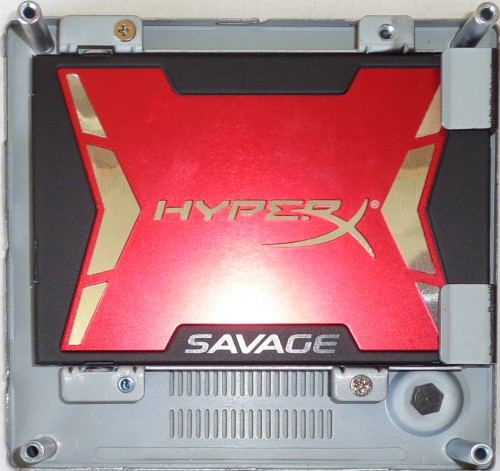
Here is the location for a 2.5 ″ drive / SSD, it will be glued to the bottom wall just like on the Brix Pro.
The test platform
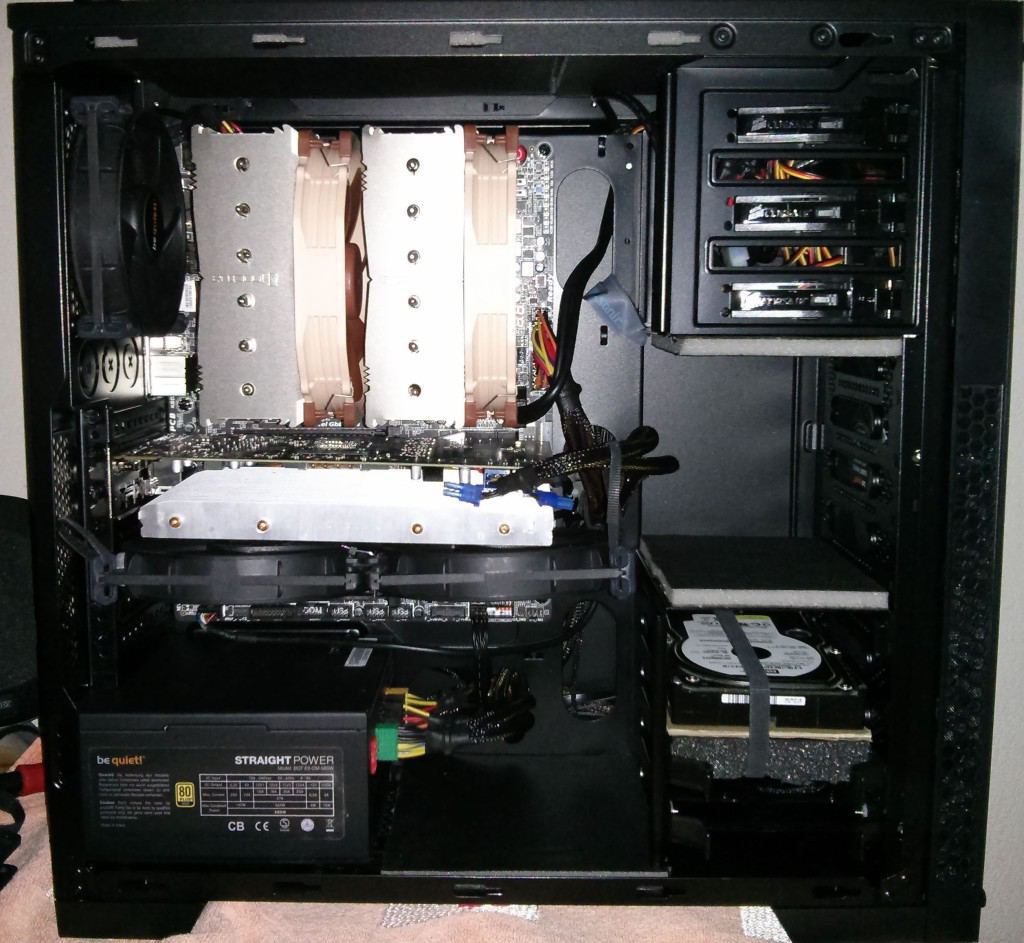
The Brix S i7 5500 will be compared to the following configuration:
- Processor : Intel Core i7 4770K
- CPU Fan : Noctua NH-D15
- Motherboard : Gigabyte Z87X-UD5TH
- Mémoire: Kingston HyperX 4 x 2 Go 1600Mhz
- Disque dur: WD Raptor 150 Go
- Ventirad Graphics Card : Arctic Cooling Accelero S1
- Alimentation: be quiet! E9 580CM
- Case : Corsair Carbide 300R
Of course the results will necessarily be to the advantage of the test configuration, but it will be a good point of comparison! The graphics card has been removed in favor of the integrated Intel HD4600 chipset.
The temperature, consumption and noise tests were carried out under OCCT in order to push the machine to its limits.
Cinebench R15
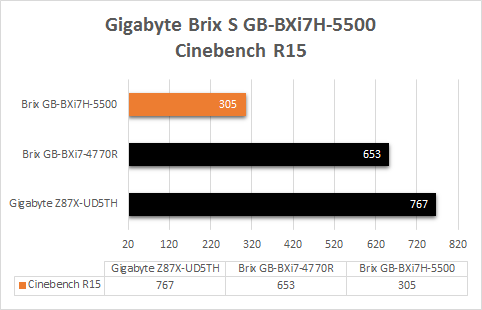
With 2 physical cores and 2 virtual cores less, the Core i7 5500U is no match for the other 2 Core i7s in the comparison, and that’s normal! However, let’s be relativistic because 305 is very close to a desktop Core i3 Haswell.
SuperPI 32M
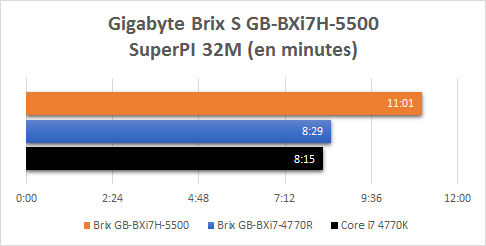
Using only one thread the frequency plays a major role here, as on Cinebench R15 the Core i7 5500U is behind with 11 minutes compared to the 8 minutes of the other Core i7s. This is easily explained by seeing that the turbo mode of the 5500U is “only” 3 GHz.
Aida64 4.60
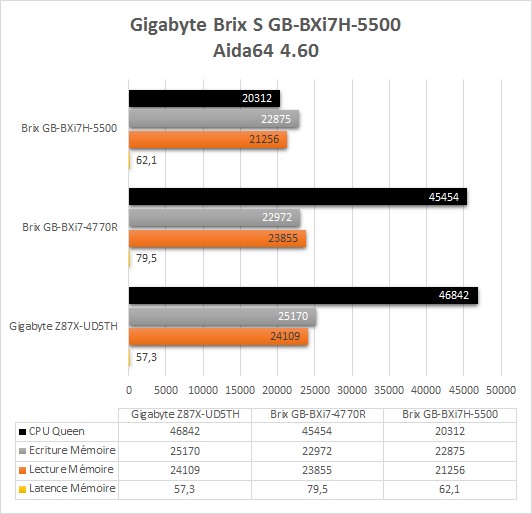
In terms of memory under Aida64, the speeds are not far from the other solutions in the comparison, which is quite normal. The result under CPU Queen is once again in line with what we saw above namely more than 50% worse, again this is quite normal.
3DMark Fire Strike & Jeux
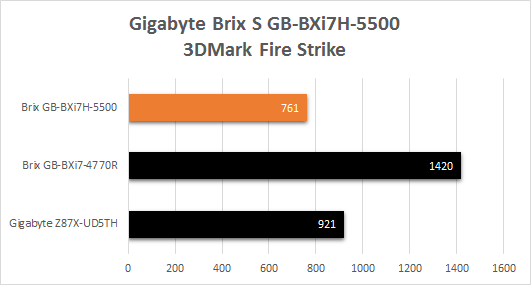
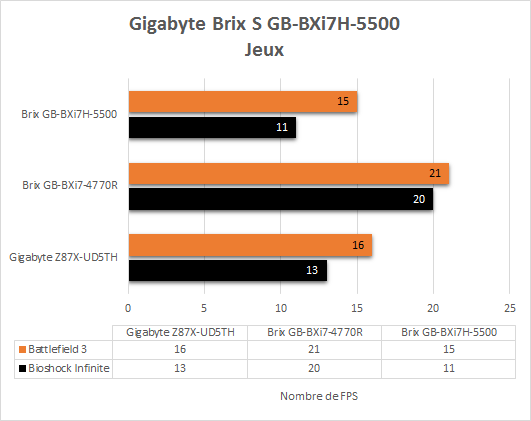
The graphic part of the i7 5500U is clearly not made for playing, or you will have to pay great attention to graphic details and not expect miracles (games like LOL, HOTS or even Diablo 3 should however be fully playable. ). We can see that the HD 5500 chipset is also behind compared to the HD 4600 of the Core i7 4770K, which is itself far from the Iris Pro 5200 of the Core i7 4770R which equips the Brix Pro.
Débits Sata – CrystalDiskMark
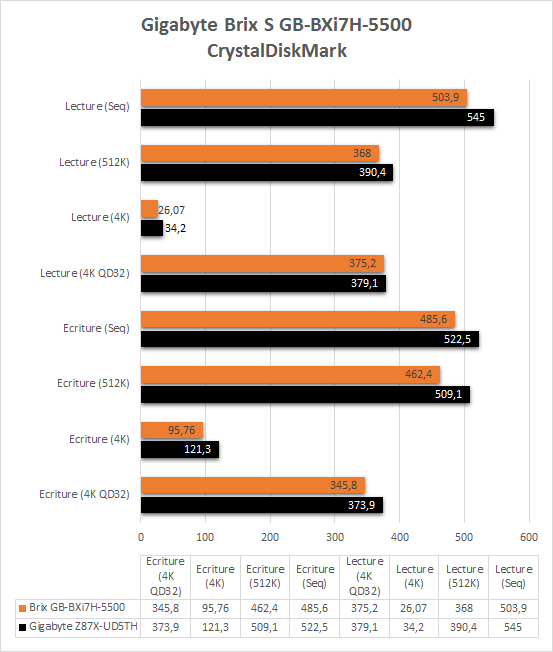
I purposely removed the Brix Pro from the comparison as there was no point of comparison, so I took a Kingston HyperX Savage 240GB SSD (tested here) and it was tested on the Core i7 4770K and the Brix S (the Brix Pro is no longer in my possession).
As we can see the Brix defends itself really very well by having read and write performance almost identical to its big desktop brother, we can say that there is really no clamping here and the SSD responds to the finger and at the eye.
Network speeds
The throughput was tested by transferring a 7GB iso file hosted on a machine running Debian Wheezy and all over a Gigabit network.
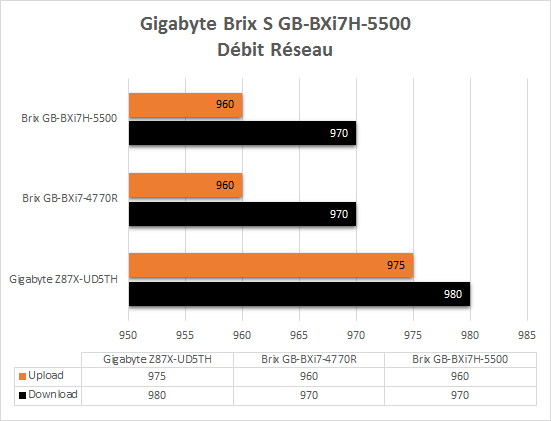
At the network level, the Brix S has no problem keeping up with the speed with 970Mb / s in download and 960Mb / s in upload, same results as with the Brix Pro, the Intel chipset present on the Gigabyte Z87X-UD5TH is more efficient but nothing that changes from the ordinary here.

The Gigabyte Brix S GB-BXi7H-5500 WiFi card has been tested in real conditions, and not glued to a high-end router specially purchased for the occasion, in fact in 99% of cases the PC is connected to the box so it will be the same for this test! The connection is made to a SFR NB6 box (optical fiber with a speed of 1Gb / 200Mb) and through a wall.
By the way, we see that the Wifi chipset is really very good with 38.07 Mb / s in download and 41.81 Mb / s in upload, better than the Brix Pro but very slightly worse than the Wifi card installed on the Z98X-UD5TH motherboard . It is very likely that the possible speeds will not restrict your connection (unless you have fiber or VDSL2).
Temperatures

In terms of temperatures at rest, the Brix S behaves very well (for such a small PC of course) with 51 ° for the processor and the motherboard as well as 45 ° for the SSD. The SSD is a little hot but nothing that should endanger its life.
In load we go up to 85 ° for the processor and the motherboard and 46 ° for the SSD, again even if this may seem high it is not so because this processor can remain at this temperature without the slightest concern for its duration of life (The Brix Pro’s Core i7 rose to 97 ° to compare).
Consumption
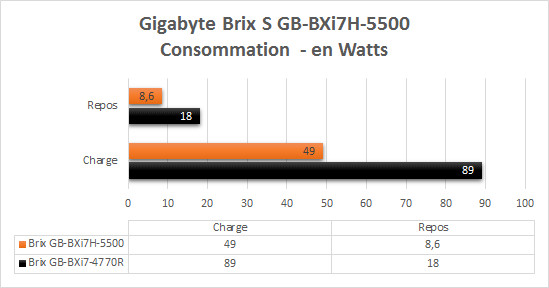
So there is as much to say that Gigabyte has worked very well, at rest the complete machine consumes 8.6 Watts at the outlet, which is quite simply ridiculous and buries its big brother Brix Pro of about 10 Watts (which was already low in energy with its 18 Watts). On the other hand, the gap widens even more with a maximum of 49 Watts at the outlet for the Brix S against 89 Watts for the Brix Pro, nothing to say in terms of consumption the Brix S i7H-5500 is doing. perfectly.
Noise
Warning: Part to be taken with a grain of salt, unfortunately not having access to the appropriate equipment and using an android application to take the readings The measurements below are only indicative! The readings were taken 20cm from the machine.
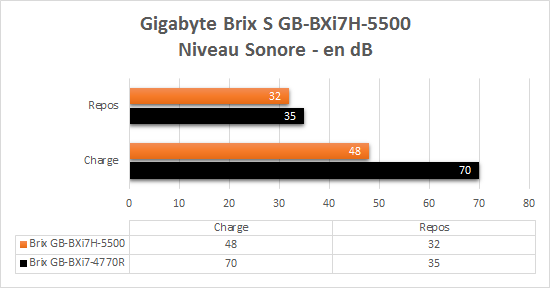
Here again the Brix S behaves very differently from its big brother the Brix Pro, indeed at rest and with its 32 dB it is almost completely silent, in any case it will clearly not be heard if there is every other sound source. Under load on the other hand and with 48 dB it is clear that we will not be able to miss the little beast which cries from the top of its more than 5000 RPM, but it remains well below the Brix Pro and its 70 dB which was almost unbearable .

Here we are at the end of this test, what about the Brix S GB-BXi7H-5500?
For starters Gigabyte took a Brix Pro which was already tiny and reduced its height even further, making placement very easy, behind a screen for example with its VESA mount. The build quality as well as the robustness of the whole are really excellent, no worries at this level.
In terms of performance, we are below a Brix Pro with 2 fewer physical cores but the Brix S manages to do almost as well as a desktop Core i3 Haswell, so as much to say that it will be more than enough for all daily tasks. The integrated graphics chip will allow you to do whatever a user needs, and even play a few small games (LOL style for example) but clearly you should not expect miracles.
Unlike the Brix Pro, the S version manages to keep temperatures correct for its size, as well as much more contained noise pollution, even if the beast will be clearly heard in load, in office use (which is the main use of this device). Brix S) it will be very discreet.
Regarding the price on the other hand there is no miracle, the Core i7 5500U itself is offered at $ 393, the Brix S i5H-5500 is offered at a price between 550 and 600 €, so yes it remains expensive for the performances offered but the miniaturization of the whole has to be paid for, and as usual we have nothing for nothing! It is also necessary to take into account the fact that in addition to the Brix S itself it is necessary to add memory (between 40 and 50 € for 2 x 4 GB) and an SSD (from 60 to xxx €). If you are looking for the smallest possible office PC without losing performance compared to a classic office PC then the Brix S GB-BXi7H-5500 is undoubtedly an excellent choice, if the budget allows it
Advantages
- Cut
- Performances
- Build quality
A big thank you to Wilfried from Gigabyte who allowed me to do this test.













